NCERT Solutions for Class 9 Economics Chapter 1 The Story of Village Palampur
NCERT Solutions for Class 9 Social Science Economics Chapter 1 The Story of Village Palampur contain answers to the textbook exercise questions. The NCERT solutions are easy and accurate that helps with the questions asked in the examinations. These solutions cover all the questions of the chapter in detail. NCERT Solutions for Class 9 Social Science Economics Chapter 1 are prepared by our subject experts in very easy language. All our solutions are updated as per the latest CBSE Syllabus and Guidelines.
Class 9 Social Science Economics Chapter 1 NCERT Solutions
Let’s Discuss Page No. 3
Question 1: The following Table 1.1 shows the land under cultivation in India in units of million hectares.
Plot this on the graph provided. What does the graph show? Discuss in class.
Table 1.1: Cultivated area over the years
| Year | Cultivated Area (in Million Hectares) |
| 1950-51 | 129 |
| 1990-91 | 157 |
| 2000-01 | 156 |
| 2010-11 | 156 |
| 2011-12 | 156 |
| 2012-13 | 155 |
| 2013-14 | 156 |
| 2014-15 | 155 |
Answer: The above graph shows the land under cultivation in India in units of million hectares.
The graph shows that the land under cultivation in India was 120 million hectares in 1950 which rose to 140 million hectares in 1970 and remained constant at 140 million hectares till 2000.
Question 2: Is it important to increase the area under irrigation? Why?
Answer: Yes, it is important to increase the land area under irrigation firstly so that the farmers can do multiple cropping and grow more than one crop in a year and increase their production and earning. Secondly, use of HYV seeds need of plenty of water to give best results.
Question 3: You have read about the crops grown in Palampur. Fill the following table based on information on the crops grown in your region
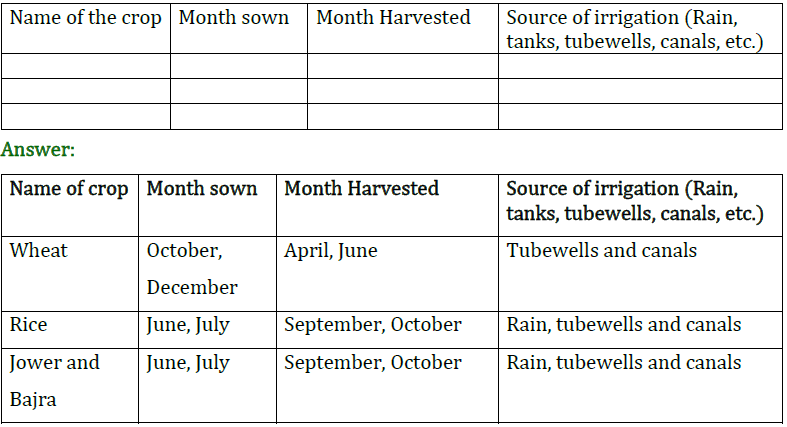
Let’s Discuss Page No. 5
Question 1: What is the difference between multiple cropping and modern farming method?
Answer: Multiple Cropping To grow more than one crop on a piece of land during the year is known as multiple It is the most common way of increasing production on a given piece of land Modern Farming Method The farmers of Haryana and Western Uttar Pradesh use HYV seeds, tube wells for irrigation, chemical fertilizers and pesticides, as well as machinery like tractors and threshers to increase production. All these measures comprise what are known as modem farming methods
Question 2: The following table shows the production of wheat and pulses in India after the Green Revolution in units of million tonnes. Plot this on a graph. Was the Green Revolution equally successful for both the crops? Discuss.
| Production of Pulses | Production of Wheat | |
| 1965 – 66 | 10 | 10 |
| 1970 – 71 | 12 | 24 |
| 1980 – 81 | 11 | 36 |
| 1990 – 91 | 14 | 55 |
| 2000 – 01 | 11 | 70 |
| 2010 – 11 | 18 | 87 |
| 2012 – 13 | 18 | 94 |
| 2013 – 14 | 19 | 96 |
| 2014 – 15 | 17 | 87 |
| 2015 – 16 | 17 | 94 |
| 2016 – 17 | 23 | 99 |
| 2017 – 18 | 24 | 97 |
Answer: Between 1965 and 2001, the production of pulses has increased negligibly whereas the production of wheat increased greatly. Thus, we can say that the Green Revolution was more successful in increasing the production of wheat as compared to pulses.
Question 3: What is the working capital required by the farmer using modern farming methods?
Answer: The working capital required by the farmer using modern farming methods are raw material and money. Money is always required during production to make payments and buy other necessary items.
Question 4: Modern farming methods require the farmer to start with more cash than before. Why?
Answer: Modern farming methods require the use of HYV seeds which needs chemical fertilizers and pesticides to produce best results and increased production. However, for buying all these inputs a lot of money is needed so a farmer needs to have more cash to start farming.
Let’s Discuss Page No. 7
Question 1: In the Picture 1.5, can you shade the land cultivated by the small farmers?
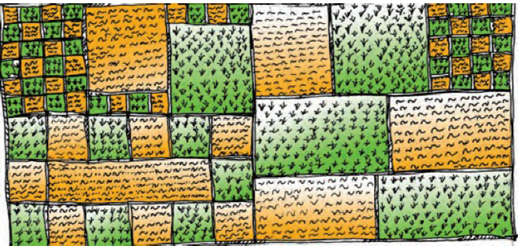
Answer: The shaded rectangles with boundaries show the land cultivated by small farmers.
Question 2: Why do so many families of farmers cultivate such small plots of land?
Answer: Land in Palampur is fixed and 75% of the people who are working are dependent on farming for their livelihood. Since land is fixed and maximum people are dependent on land they are forced to cultivate small plots of land.
Question 3: The distribution of farmers in India and the amount of land they cultivate is given in the following Graph Discuss in the classroom.
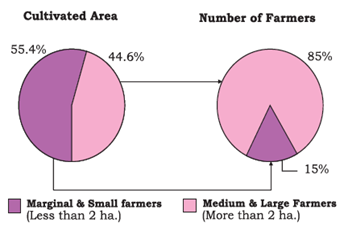
Answer: Yes, I agree that the distribution of cultivated land is unequal in Palampur because out of the 450 families, 150 families are landless, 240 families cultivate small plots of land less than 2 hectares in size whereas 60 medium and large farmers cultivate more than 2 hectares of land, a few of them have land extending over 10 hectares or more, which shows that medium and large farmers have more land though they are numerically Smaller. This clearly shows the inequality in the distribution of cultivated land. According to the graph, a similar situation exists for India also which means that 80% of the small farmers cultivate only 36% of the cultivated area whereas 20% of the big farmers cultivate 64% of the cultivated area
Question 4: Would you agree that the distribution of cultivated land is unequal in Palampur? Do you find a similar situation for India? Explain.
Answer: Do it yourself.
Question 5: Identify the work being done on the field in the Pictures 1.6 and arrange them in a proper sequence.
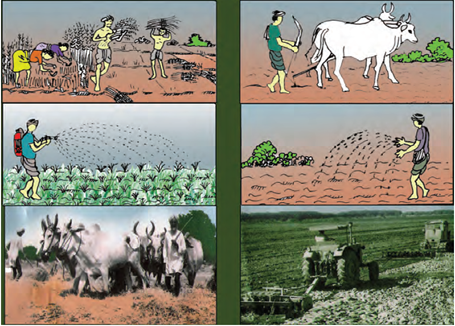
Answer: The proper sequence of the activities is given below (the numbers are marked alongside each picture).
(1) Plowing by bullocks
(2) Sowing
(3) Spraying of insecticides
(4) Cultivation by traditional methods
(5) Cultivation by modern methods
(6) Cutting of crops
Let’s Discuss Page No. 9
Question 1: Why are farm labourers like Dala and Ramkali poor?
Answer: (a) Dala and Ramkali are landless farm labourers who work on daily wages in Palampur.
(b) Though, minimum wages for farm labourers set by the government is 60 per day, they get only 35-40
(c) There is heavy competition for work among the farm labourers in Palampur, so people agree to work for low wages.
(d) They remain out of work for most parts of the year and have to take loans from the
moneylender to fulèll their needs. Due to this seasonal unemployment, they remain poor and are unable to repay the loan and fall into a debt trap.
Question 2: Gosaipur and Majauli are two villages in North Bihar. Out of a total of 850 households in the two villages, there are more than 250 men who are employed in rural Punjab and Haryana or in Delhi, Mumbai, Surat, Hyderabad or Nagpur. Such migration is common in most villages across India. Why do people migrate? Can you describe (based on your imagination) the work that the migrants of Gosaipur and Majauli might do at the place of destination?
Answer: Mostly people migrate in search of employment or better job Opportunities to the cities like Mumbai, Delhi etc or to the prosperous agricultural regions like Punjab and Haryana to work as farm labourers.
(a) This migration usually takes place when a person is unemployed or in extreme poverty, which may be due to lack of land, displacements, negative impact of natural disasters like drought or floods, etc.
(b) The migrants from Gosaipur and Majauli who went to cities will probably find work as casual labourers, industrial workers, street hawkers, rickshaw pullers, headload workers or as servants in homes and hotels, etc
(c) Those who went to rural areas of Punjab and Haryana will probably work as farm labourers since agriculture is the main occupation of the rural people in these states.
Let’s Discuss Page No. 11
Question 1: Let us take three farmers. Each has grown wheat on his èeld though the production is different (see Column 2). The consumption of wheat by each farmer family is the same (Column 3). Me whole of surplus wheat this year is used as capital for next year’s production. Also suppose, production is twice the capital used in production. Complete the tables.
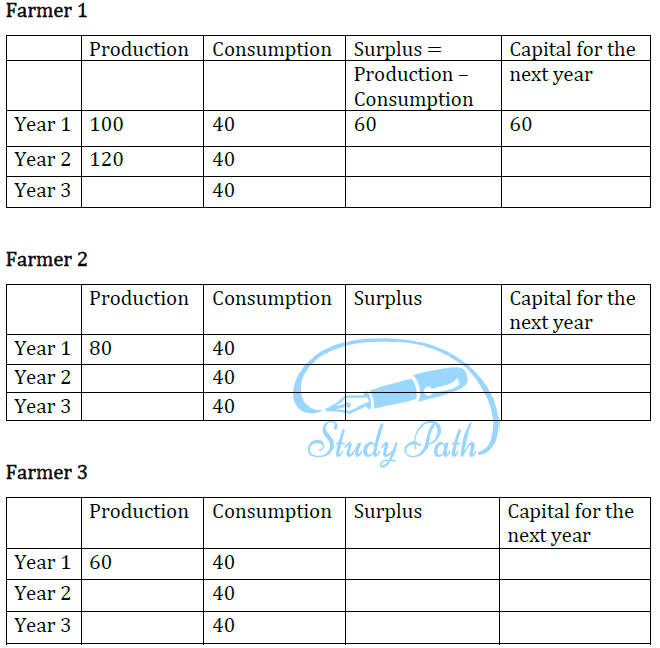
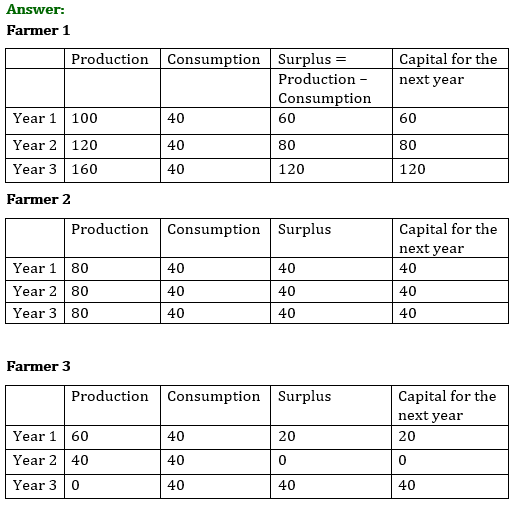
Question 2: Compare the Production of wheat by the three farmers over the years.
Answer:
| Farmer 1 | Farmer 2 | Farmer 3 | |
| Year 1 | 100 | 80 | 60 |
| Year 2 | 120 | 80 | 40 |
| Year 3 | 160 | 80 | 0 |
• The production of wheat of the first farmer increased from 100 to 16CL
• The production of wheat of the second farmer was constant at 8CL
• The production of wheat of the third farmer declined from 60 to 0
Question 3: What happens to Farmer 3 in Year 3? Can he continue production? What will he have to do to continue production?
Answer: In the third year, the third farmer did not produce any wheat and had to buy it
from the market. He cannot continue production any longer unless he arranges capital, as he has no surplus to invest as capital.
Let’s Discuss Page No. 12
Question 1: What capital did Mishrilal need to set up his jaggery manufacturing unit?
Answer: To set up his manufacturing unit Mishrilal needed the following capital
(a) Fixed Capital in the form of the sugarcane crushing machine. Working Capital in the form of money for buying sugarcane from other farmers for crushing and for paying the electricity bill of running the
(b) crushing machine.
Question 2: Who provides the labour in this case?
Answer: The labour is provided by him and his family. Otherwise he will employ landless labourers
Question 3: Can you guess why Mishrilal is unable to increase his profit?
Answer: (a) Mishrilal has set up a small scale unit.
(b) The farm holdings in the village are very small of about 2 hectares in size and production of sugarcane is low as more area is under wheat, so raw material is also less (c) He has to pay for the electricity to run the machine.
(d) Since the industry is small scale, production is less and therefore, he is unable to increase his profit.
Question 4: Could you think of any reasons when he might face a loss?
Answer: Conditions under which he may face a toss can be any of the following
(a) If his crushing machine becomes defective, his production will reduce or totally stop.
(b) If due to drought or other calamity, the production of sugarcane in nearby areas reduces; his jaggery production will come down leading to a loss for him.
(c) If the demand for jaggery decreases, ne will not be able to sell enough to break even.
(d) If any other costs like electricity, labour or transportation costs increase, he may face a loss.
Question 5: Why does Mishrilal sell his jaggery to traders in Shahpur and not in his village?
Answer: (a) Palampur is a small village with 450 families and there is not a big demand for jaggery there.
(b) Shahpur is a town where people come from different surrounding villages to buy things and there is more demand of jaggery there, so Mishrilal sells his jaggery traders in Shahpur and not in his village.
Let’s Discuss Page No. 12
Question 1: In what ways is Kareem’s capital and labour different from Mishrilal?
Answer: 80th have fixed capital in the form of machines, but Kareem has a larger fixed capital because he has assets in the form of computers which are more expensive than the sugarcane crushing machine. Kareem has also employed educated and qualified computer teachers, whereas Mishrilal labour is mainly unskilled labour
Question 2: Why didn’t someone start a computer centre earlier? Discuss the possible reasons
Answer: Reasons why someone didn’t start a computer centre may be any of the following
(a) As very few educated people were there in the village, there was not any demand for computer courses.
(b) The villagers were not aware of the employment potential of computer courses and so nobody thought that such a business could be successful.
(c) Teaching faculty for computer courses was not available
Let’s Discuss Page No. 13
Question 1: What is Kishora’s fixed capital?
Answer: Kishora’s fixed capital is the buffalo and wooden-cart which he has purchased with the bank loathe
Question 2: What do you think would be his working capital?
Answer: The money that he earns from selling the milk and transporting goods an his bullock-cart minus his own living expenses are his working capital.
Question 3: In how many production activities is Kishora involved?
Answer: Kishora is involved in the following production activities.
(a) Selling of buffalo’s milk.
(b) Transporting of various items.
(c) Bringing clay from the river Ganga for the potter
(d) Transporting jaggery etc to Shahpur.
Question 4: Would you say that Kishora has benefitted from better roads in Palampur?
Answer: Kishora has certainly benefitted from better roads in Palampur because he is involved in the transport business; better roads enable him to easily transport goods from one place to another, run his business successfully and earn profits, which would have been very difficult in the absence of proper roads.
Exercises
Questions 1: Every village in India is surveyed once in ten years during the Census and some of details are presented in the following format. Fill up the following based on information on Palampur.
(a) LOCATION:
(b) TOTAL AREA OF THE VILLAGE:
(c) LAND USE (in hectares):

(d) FACILITIES:
| Educational | |
| Medical | |
| Market | |
| Electricity Supply | |
| Communication | |
| Nearest Town |
Answer:
(a) LOCATION: Bulandshahar district, Western Uttar Pradesh
(b) TOTAL AREA OF THE VILLAGE: 226 hectares
(c) LAND USE (in hectares):

(d) FACILITIES:
| Educational | 2 primary schools and 1 high school |
| Medical | 1 primary health centre and 1 private dispensary |
| Market | Raiganj and Shahpur |
| Electricity Supply | Most of the houses have electric connections. Electricity powers all the tube wells in the fields and is used in various types of small businesses. |
| Communication | Well-connected with neighbouring villages and towns. 3 kms from Raiganj. All-weather road connects it to Raiganj and further on toShahpur. Many kinds of transport like bullock carts,tongas, bogeys, motorcycles, jeeps, tractors and trucks are present. |
| Nearest Town | Shahpur |
Question 2: Modern farming methods require more inputs which are manufactured in industry. Do you agree?
Answer: Modern farming methods involve the use of high-yielding variety seeds. These seeds require a combination of chemical fertilisers and pesticides, agricultural implements like tractors, and proper irrigation facilities like electric tube wells to produce the best results. All these elements are manufactured in industries. Hence, it would be right to say that modern farming methods make use of a greater number of industrial outputs as compared to traditional farming methods.
Question 3: How did the spread of electricity help farmers in Palampur?
Answer: The spread of electricity has helped the farmers of Palampur village in the following ways:
- Most of the houses have electric connections.
- Electricity is used to run tubewells in the fields.
- Electricity is used in various types of small business.
Question 4: Is it important to increase the area under irrigation? Why?
Answer: India is an agricultural country. Of the total cultivated area in the country a little less than 40 per cent is irrigated even today. In the remaining areas, farming is largely dependent on rainfall. In India, rainfall is not regular and irrigation is important to get better crop yield and hence it is important to increase the area under irrigation.
Question 5: Construct a table on the distribution of land among the 450 families of Palampur.
Answer: Number of families Land (hectare)
| Number of families | Land (hectare) |
| 150 | 0 |
| 240 | Less than 2 |
| 60 | More than 2 |
Question 6: Why are the wages for farm labourers in Palampur less than minimum wages?
Answer: Farm workers at Palampur village get lower wages than the minimum wages fixed by the government. The minimum wages for a farm labourer is fixed at Rs 115 per day. But farm labourers get only Rs. 70 – 80. This happens because of heavy competition for work among the farm labourers at Palampur village.
Question 7: In your region, talk to two labourers. Choose either farm labourers or labourers working at construction sites. What wages do they get? Are they paid in cash or kind? Do they get work regularly? Are they in debt?
Answer: Do it yourself.
Question 8: What are the different ways of increasing production on the same piece of land? Use examples to explain.
Answer: The different ways of increasing production on the same piece of land are:
- Multiple Cropping: It is the most common way of increasing production on a given piece of land. Under it, more than one crop is grown on the same piece of land during the year. Indian farmers should grow at least two main crops in a year. In India, some farmers are growing a third crop also over the past 20 years.
- Modern Farming Methods: Production on the same piece of land can also be increased by adopting modern farming methods. The Green Revolution in India is a remarkable example of it. Under modern farming, more cultivable areas should be brought under HYV seeds and irrigation. The use of simple wooden plough must be replaced by tractors. The increasing use of farm machinery like tractors, threshers, harvesters, etc. make cultivation faster.
Question 9: Describe the work of a farmer with 1 hectare of land.
Answer: A farmer with 1 hectare of land shall put under the category of small farmer. Most of the work would be done by the farmer and his family members. The farmer will normally use a pair of bullocks to plough the field. His family members would assist him in sowing the seeds. During harvest time, he may require to hire some labourers.
Question 10: How do the medium and large farmers obtain capital for farming? How is it different from the small farmers?
Answer: Medium and large farmers usually have surplus cash by selling their farm produce. Since they have land and house, they easily get loan from banks. Small farmers, on the other hand, may not be able to get bank loans. They have to depend on the local merchant and moneylender for loan.
Question 11: On what terms did Savita get a loan from Tajpal Singh? Would Savita’s condition be different if she could get a loan from the bank at a low rate of interest?
Answer: Savita required money for buying seeds, fertilisers and pesticides, and water for irrigation. She also needed money for repairing her farm instruments. So, she decided to borrow money from Tejpal Singh, a large farmer in her village. Tejpal Singh agreed to give the loan of Rs. 3000 at an interest rate of 24 per cent for four months. He also got her to agree to work on his field during the harvest season for Rs. 35 a day.
Savita’s condition would have been better if she could get a loan from the bank. The bank would have provided her the loan at a low rate of interest. Moreover, Savita could have devoted more time on her own field instead of working for Tejpal Singh as farm labourer.
Question 12: Talk to some old residents in your region and write a short report on the changes in irrigation and changes in production methods during the last 30 years. (Optional)
Answer: Attempt this question on your own.
Question 13: What are the non-farm production activities taking place in your region? Make a short list.
Answer: Cycle repair shop, carpenter, ironsmith, general store, tea stall, stationary shop, computer training institute, etc.
Question 14: What can be done so that more non-farm production activities can be started in villages?
Answer: The government should improve electricity supply in the villages. It should open more schools so that children can grow to become educated adults. Moreover, government can also provide vocational training to the rural youths. These activities would help in increasing non-farm production activities in a village.
Or
Three things that need to be done to encourage non-farm production activities in villages:
- The government should set up schemes whereby landless labourers and small farmers are able to get cheap loans to start small individual/community businesses.
- In addition to financial assistance, the government should set up rural workshops to enable the villagers to build on their skill levels.
- The government should also work towards improving the infrastructure of villages so that the rural parts of the country are well connected to the urban areas.